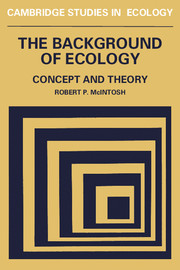Book contents
- Frontmatter
- Contents
- Preface
- Acknowledgments
- 1 Antecedents of ecology
- 2 The crystallization of ecology
- 3 Dynamic ecology
- 4 Quantitative community ecology
- 5 Population ecology
- 6 Ecosystem ecology, systems ecology, and big biology
- 7 Theoretical approaches to ecology
- 8 Ecology and environment
- References
- Name index
- Subject index
4 - Quantitative community ecology
Published online by Cambridge University Press: 05 August 2012
- Frontmatter
- Contents
- Preface
- Acknowledgments
- 1 Antecedents of ecology
- 2 The crystallization of ecology
- 3 Dynamic ecology
- 4 Quantitative community ecology
- 5 Population ecology
- 6 Ecosystem ecology, systems ecology, and big biology
- 7 Theoretical approaches to ecology
- 8 Ecology and environment
- References
- Name index
- Subject index
Summary
Among the more startling assertions in the contemporary ecological literature are “Community ecology is in its infancy” (Pianka 1980) and “Recently ecologists have expanded their scope from studies of single species populations to include analysis of broader assemblages of several co-occurring species loosely defined as communities” (Peterson 1975). In fact, the study of communities or assemblages of co-occurring species is one of the oldest of concerns that may be reasonably identified as ecological. The clearest way to distinguish self-conscious ecology from the other elements of natural history, genetics, physiology, or evolution with which it overlaps is its concern with organisms as members of multispecies aggregates, under a variety of pseudonyms: census, formations, coenoses, associations, societies, guilds,or more generally, communities.The long tradition of natural history, the ordinary experience of farmers, seamen, woodsmen, hunters, anglers, and herbalists, indeed, of the earliest of food gatherers, and the plethora of words in many languages describing particular kinds of aggregates of organisms, and often their associated habitats, testifies that the earth is covered with a complex pattern of “more or less” recognizable plant and animal communities.
Biogeographical origins
Although references to communities studded the classic literature of natural history, it is usual to attribute to Humboldt the earliest formal recognition of “association” based on the growth forms of the plants which gave the association the distinctive appearance or physiognomy by which it was recognized (Humboldt and Bonpland 1807).
- Type
- Chapter
- Information
- The Background of EcologyConcept and Theory, pp. 107 - 145Publisher: Cambridge University PressPrint publication year: 1985
- 2
- Cited by

